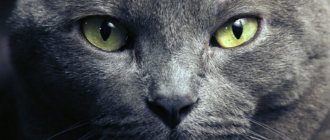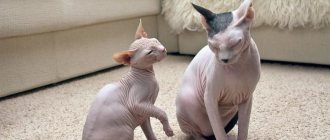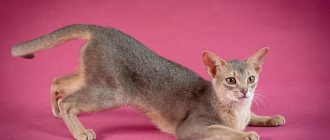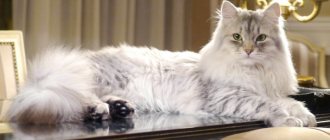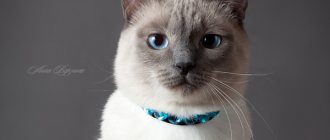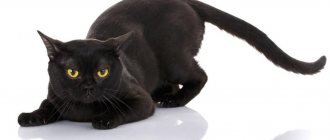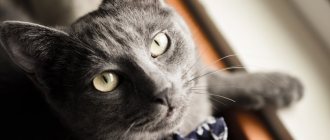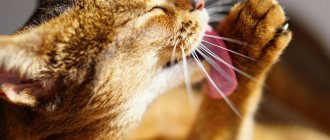Representatives of this breed, like other furry pets, regardless of gender and age, can be charming, playful and playful.
Here useful information will be provided on how to organize food, how to take care of the fur, how to care for it in case of illness, and other things that those who have chosen a Siberian blue cat as a pet need to know.
This information will be useful and interesting to those who adore cats and want to purchase or adopt a representative of this breed into their home. However, you need to know that the cost of these beauties is usually quite high, due to the unique features of the breed, however, there are exceptions.
Behavior and character of cats
The facial expression of furry giants is always relaxed and serene. Only their owners know what their character really is.
They can serve and bring things if they are trained to do so. Siberian cats are silent, this is a feature of their psyche. The vast majority of these animals are very balanced, restrained, and unobtrusive. They prefer to be nearby unnoticed, without annoying with their presence. Cats sense their owner’s mood and always come when they feel bad, trying to console them.
The overly active temperament of some young pets can be tiring. A kitten needs to play a lot for normal development. It is advisable to buy a multi-level complex so that there is room to run and jump.
Watch this video on YouTube
Description of the Neva Masquerade breed
The pride of Russian breeders was born naturally. Siberians had love affairs with Siamese cats, and the fruit of this love was the Neva Masquerade cat. From his Siberian father, the Nevak inherited a strong and strong body, very thick wool with special properties and good health (but not without nuances). The Siamese mother gave me a masquerade costume - a light body, a dark mask, tan marks on the paws and tail, as well as unusual blue and very bright eyes. This elegant appearance will never go unnoticed!
Below are the main features of the breed, described in the standard of the Neva Masquerade cat:
- Head
Cats and cats of this breed have a large head, shaped like a short trapezoid. The forehead, according to the breed standard, is wide and rounded, the transition to the back of the nose is smooth. There is no stop. The chin is not prominent, but strong and powerful. The cheeks are dense.
The ears are set wide apart (the distance between the ears is greater than the width of one ear), slightly tilted forward. Brushes and tassels on the ears are welcome.
The eyes are round, set wide and slanted. The lower eyelid is semicircular, the upper is arched. The eye color is blue, and representatives of this breed can have eyes of different shades - lavender, Mediterranean, blue, sapphire and so on.
- Body
The Neva masquerade cat is considered one of the largest in the world. Its size is slightly inferior to the giants - Maine Coons. Their ancestors endowed these animals with strong bones and well-developed muscles.
Neva masquerade cats have strong limbs that form an almost perfect rectangle in proportion to the body. The paws are round and large, with fur growing between the toes.
The tail is wide and strong at the base, the tip of the tail is rounded. The pubescence is notable.
Cats of the Neva Masquerade breed weigh about 6 kg, and males can exceed the bar of 8-9 kg.
- Wool
Neva masquerade kittens are born with wool that has unique characteristics: it is, as reviews from owners say, dirt- and water-repellent and, moreover, does not form tangles! The classic Neva Masquerade cat has medium-length fur. It becomes longer from the shoulder blades to the croup, and the fur on the sides is softer than on the back.
The Siberian Color Point has beautiful panties, a luxurious collar, a plume on the tail and a double undercoat throughout the body. It is curious that when a cat sheds, the collar and panties almost completely disappear.
IMPORTANT! The smooth-haired Neva masquerade cat is perhaps the only representative of the long-haired breeds, which, due to the characteristics of its coat, is practically non-allergenic
- Color.
At first glance, it may seem that the colors of representatives of this breed are quite monotonous, but this is not so. There are at least 6 color variations of Nevaks!
The most common are “Seal-point”, which gets its name from the English word “seal” and “Seal tabby point”. Translated into the St. Petersburg cat dialect, this means that a kitten of this color will have light hair on the body and dark points on the paws, tail, ears and face. Black+white coloring is also possible.
Another type of color of the Neva Masquerade cat is “Red-point”. This tone implies color transitions into the red spectrum.
“Blue-point” – bluish intonations in color.
Tortie-point is, as a rule, only found in cats.
Nevaks with silver shades for all of the above combinations of color points are becoming more and more common.
Snow-white socks on the paws and spots of the same color and tone on the face are acceptable in all color variations. Neva masquerade bicolor does not require symmetry and orderliness of the shapes of the spots.
But the chocolate-lilac color scheme is prohibited.
IMPORTANT! Kittens of this breed are born exclusively white. This is explained by the fact that the specific color of the Neva cat is formed by a special heat-sensitive gene, which prevents pigments from penetrating into the hair at high temperatures.
In other words, the colored areas of the fur (ears, face, paws and tail) are the coldest places on cats.
Wikipedia lists the main disadvantages of the breed, including even slight darkening of the fur on the body.
Features of color
The animals received their characteristic smoky blue color as a result of crossing relatives of silver color and recessive colors with no agouti. The color standard provides for a monochromatic coloring of the animal without any pronounced pattern or points. Whitish spots on the face, chest or body are not acceptable. Outwardly, this coloring looks noble; the fur coat, which shimmers in the light with a silvery sheen, gives the pets a special status.
The degree of color saturation can be different (both light and dark), however, the shade should be the same for one animal. Shading of certain parts of the body is considered a fault. This is usually typical for small kittens: their legs and back are often darker, and a tabby pattern can be seen along the body. However, with the first molt, this drawback is eliminated, and the color evens out to a uniform color. To prevent your pet from acquiring rusty spots, it must be protected from the sun.
Nibelung: breed differences
The Nibelung has a luxurious, long and soft gray-blue coat. The color of each hair smoothly transitions from dark/light gray to bluish, and the tips of the hairs are silver. It appears that this animal has a smoky halo. All this splendor is complemented by large emerald-colored eyes. And the greener they are, the better.
The body of this cat is medium in size, slender, slightly elongated, the tail is fluffy and long (wide at the base and tapering towards the tip). Long, slender limbs. The paws are small and oval, which makes her walk soft. The pads are gray-pink in color. Representatives of this breed have an aristocratic appearance: a straight nose, translucent skin of the ears, graceful movements.
Possible deviations
Siberian blue cats are not allowed to participate in exhibitions with:
- an elongated and puny body, a thin skeleton, long limbs and neck;
- narrow, high cheekbones, flattened muzzle with a sharp chin;
- small, round eyes deeply sunk into the skull;
- large or small ears located close to each other;
- short or long tail, not fluffy enough;
- weak or absent undercoat;
- not shiny, tending to get tangled with guard hairs;
- hairless indentations between the toes.
Description of appearance and standards
Siberian cats are quite large animals. Females of this breed weigh up to six kilograms, and males - up to twelve. But they are very mobile and have good jumping ability due to the fact that their hind legs are slightly longer than their front legs.
Siberian cats are quite large and powerful animals.
The Siberian fur coat is beautiful and practical. A distinctive feature is the frill and panties. Their coat is of medium length and has a dense undercoat, which helps the animal feel quite comfortable even in severe frosts. The body is muscular and strong, making the Siberian cat an excellent hunter.
Siberians belong to the “forest type” along with the Norwegian forest cat and Maine Coon. And if at first glance these animals are similar, then upon closer examination each will have its own characteristics. For example, the head of a Maine Coon has angular lines, it seems to be made up of several boxes, in a Norwegian the transition from the forehead to the muzzle is practically not pronounced, a kind of straight line, and in a Siberian the profile is smoother compared to the Maine Coon, but the transition from the forehead towards the muzzle is more clearly expressed than in the Norwegian Forest.
Forest type cats have significant differences in head structure
A common feature of “forest type” cats can be the so-called wild color (various agouti, including white, as well as brindle, spotted and marbled). But recently, breeders have become interested in breeding Siberian cats of all kinds of colors (since they are more in demand among exotic lovers), so after looking at the offers of different breeders, I got the impression that soon the ordinary “mustachioed-striped” will be considered exotic.
Table: SFF Siberian breed standard (adopted in 1990)
| general characteristics | Strong, massive, muscular animals of large and medium size. Cats are much smaller than cats. |
| Head | Short wide trapezoid shape in good proportion to the body. The top of the head is flat. A smooth transition from a low forehead to a wide, straight bridge of the nose. The nose is of medium length without stop or snub. Cheekbones are low, cheeks are full. Strong jaws. The chin is wide, fairly strong, but not protruding. |
| Neck | Strong, short |
| Ears | Medium size, wide at the base, spaced at a distance greater than the width of one ear at the base. The outer line of the ear is vertical, the outer edge of the ear is located slightly above eye level. The ears are slightly tilted forward. The ends are rounded. Brushes and brushes are desirable. |
| Eyes | Large and medium-sized, rounded, set wide and slightly oblique |
| Eye color | Green or yellow of all shades, evenly colored. Color-point (Neva Masquerade) and white cats have blue eyes. Disagreement in the colors “van” and “white”. |
| Type | Strong, massive |
| Body | Dense, massive, with prominent muscles, of medium length on strong short limbs. The paws are large and round. Tufts of fur between the toes. |
| Tail | Wide and strong at the base, almost reaching to the shoulder blades. Well pubescent, ending bluntly. |
| Wool | The outer hair is hard, shiny, water-repellent, lengthening from the shoulder blades to the croup, descending to the sides and upper part of the tail. On the sides the coat is softer, loosely fitting, and very dense. The undercoat is double, depending on the season: light, short, close-fitting in summer, abundant in winter, long, very thick and dense, with excellent texture. The decorative coat is long but dense, in the form of a mane, full collar and frill. Lush “pants” and a perfectly bushy tail. Short hair on paws. During seasonal molting, almost nothing remains of the decorating fur. |
| Colors | All are allowed except lilac, chocolate, abi, all “agouti” and “tabby”, which have a more characteristic coat texture, are preferred. Cats of “color-point” and “color-point with white” colors are called “Neva Masquerade” (“Siberian color-point”). |
| Condition | Healthy, strong, robust, well-groomed cat |
| Flaws |
|
| Crossbreeding | Crossing with other breeds is not allowed |
Keeping a pet
Large and heavy Siberian cats belong to breeds of late maturation and finally complete it only at the age of five, when both males and females acquire mature forms - they mature and acquire muscle mass. Although by the age of three the animal is considered to be fully developed physically - which, however, is also not too early.
Only by the age of five will your cat fully mature and acquire the full appearance of the Siberian breed
These important factors must be taken into account when keeping animals of this breed, thinking over their diet and regulating physical activity.
Feeding
Breeding nurseries recommend high-quality ready-made food as the basis for the nutrition of Siberian cats - this way, a balanced menu is guaranteed. This is important, if only for the reason that Siberian women are prone to overeating, and too high-calorie food in combination with physical inactivity can provoke diseases of the digestive system and cardiovascular system.
But many owners still prefer to feed their pets natural food, especially since representatives of this breed love to eat not only a lot, but also delicious food. It is necessary to remember that Siberian cats, as well as all other cats, are strictly contraindicated from eating food from the master’s table. Their usual diet should consist of three-quarters of animal protein: raw meat, poultry and fish (preferably boiled). As an addition to the main menu, you can give fermented milk products, quail eggs (1-2 pieces per week), a small amount of cereals and vegetables.
Keep in mind that your Siberian pet needs its own diet
Sweets, legumes, pasta, potatoes, and baked goods should not be given to cats, as well as fatty, spicy, fried, and pickled foods. Do not experiment with the health of your pet - feed it correctly, twice a day, and in no case overfeed it. A three-month-old kitten should eat five times a day; as it grows, the number of feedings decreases, and single portions increase.
Hygiene and grooming
The abundance and thickness of the coat determine the need for careful care, which, however, is much simpler than that of the Persian breed. The beautiful coat of a Siberian cat should be combed from root to tip at least twice a week, paying special attention to areas with soft hair where there is a high risk of tangles. During the shedding period, brushing with a furminator should be made a daily procedure - otherwise all surfaces in your home and your clothes will be covered with a layer of cat fluff.
It is necessary to comb your Siberian twice a week or more often.
It is not recommended to resort to such radical methods as cutting and shaving, even if your cat does not participate in exhibitions. Drastic grooming will inevitably ruin the structure of the coat, and it will be extremely difficult to restore it.
With the correct structure, the fur of a Siberian cat has the property of self-cleaning, so there is no need to bathe the animal too often - only when it gets dirty. Any shampoo for long-haired cats is suitable for bathing. It is better not to leave the wool wet; you need to dry it with a hairdryer while combing it with a slicker. The Siberian breed is not afraid of the cold, but does not tolerate drafts at all.
If you don't comb your cat, you'll have to cut it.
Like any cat, regular care of the ears, eyes and claws is important for the Siberian. In order to prevent inflammatory diseases, the ears must be wiped weekly with special products or at least a small amount of boiled vegetable oil. Just don’t get carried away with this and don’t try to clean the ear canal too deeply - this can only cause harm. It is enough to wipe the eyes from time to time with a damp cotton swab.
The claws of Siberian cats are usually not trimmed - they renew themselves quite well. But it won’t hurt to accustom your animal to a good scratching post in a timely manner.
Physical exercise
The well-developed muscles of the Siberian cat must be constantly maintained in proper shape. Despite some external clumsiness, these animals are very mobile and, if they have the opportunity to walk in nature, they provide themselves with the necessary physical activity: they happily climb trees and roofs, and on occasion they will not refuse to swim or take part in a “safari” of anything that moves.
A cat that walks by itself will always be in good physical shape.
When kept indoors, the cat's dynamics, unfortunately, are limited to games - by the way, Siberians prefer balls to all other toys and can even learn to fetch them. But play “physical education” is not enough for normal muscle condition, so if you care about your cat’s health, provide her with regular exercise. This will also benefit your home, where the amount of destruction will immediately noticeably decrease.
You need to start training your kitten early to walk on a harness.
Be sure to walk your cat on a harness and leash. Free walking is not for a Siberian - she will almost certainly spot an enemy, victim or prey on the street and set off in pursuit, and then you will have to catch or even look for your pet for a very long time.
Video: caring for the “Siberian”
Appearance
Siberian cats and cats are distinguished by a fairly powerful physique, with well-developed muscles. They are excellent fighters who can stand up for themselves. The weight of Siberian cats varies from 4 to 9 kilograms. As we can see, it is indeed not a small animal. But, despite their size, Siberian cats look quite elegant, thanks to their smartness, playfulness and amazingly thick, long hair. An interesting impression is made by the tassels at the ends of the ears, which are sometimes found on Siberian cats. Externally, the Siberian cat is very similar to the Norwegian Forest cat; in the photo it can be difficult to distinguish them.
The head is small but wide with low-set cheekbones, a rounded face and the same chin. Proportional to body size. The forehead is slightly convex with smooth rounded features and a slight transition in the profile. The eyes are oval-shaped, medium in size, slightly slanted. The nose is wide, without protrusions along its entire length. Cheeks are full. Ears: Medium in size, wide at the base, with slightly rounded tips. The distance between them is wide, the ears protrude slightly forward.
There are individuals of both medium and large size with developed body muscles. In addition to this feature, they are characterized by: a shortish strong neck, developed muscular limbs, medium in length, large round paws (the front ones are shorter than the back ones) with tufts of hair between the toes, an elongated, pubescent tail with abundant undercoat, slightly tapering at the end.
The animal belongs to the long-haired breed. And it is the wool that is considered its main feature. But not because of the length: it does not become an allergen even for the most allergic people. The climatic features of the cat’s native nature predetermined the formation of a special wool cut, which consists of coarse wool and thick undercoat.
So, if your favorite pet is a Siberian cat, you are not afraid of allergies. Due to its hypoallergenicity, the breed is spreading everywhere with amazing speed.
The colors of Siberians are very diverse. At the moment, black brindle, colorpoint, merle and black spotted colors are known; you can often find Siberian cats with tabby and chinchilla colors. The golden and silver colors of Siberians are considered quite rare. But this is not all the surprises that the fur of these cats can present, because it can also be white or bicolor. What do you think of cats with smoky, tortoiseshell or red fur? Truly amazing variety.
How to choose a kitten
When choosing a kitten, focus on its living conditions: the cleanliness of the cage and bedding, whether the animal has toys and water. You can make a discount on a slight “cat” smell in the room
Eliminating the characteristic "orange" in a place where several fertile males live is an almost impossible task.
- Carefully examine the kitten itself. The ideal Russian Blue baby should have green eyes. Do not buy yellow-eyed animals and do not believe the breeder’s sworn assurances that with age the cat’s iris will change its hue to green.
- The fur of 3-month-old kittens should have traces of silvering; be sure to take this fact into account when purchasing. Interspersed with white hairs and spots on the baby’s fur coat are a reason to doubt the seller’s honesty. But there is no need to be afraid of slight “striations” (residual tabby). As the animal matures, this visual effect disappears.
- A healthy kitten should have clean ears and eyes. It is better not to look at individuals running away from you in full sail. This behavior signals instability of the animal’s psyche.
Serious establishments that value their own reputation begin selling kittens from the age of 3 months. Breeders who offer too young individuals simply save on costs because they do not want to feed an extra “mouth.” If you are buying a kitten in another city or country, ask the owner if he can help you with the microchipping procedure and obtaining a travel certificate. Some nurseries provide this type of support at a significant discount as a reward for making a purchase.
By the way, about nurseries. Despite the popularity of the Russian Blue breed, there are not many reliable places in Russia where one could purchase a show- or breed-class animal. It is better and safer to buy a kitten from breeders who, in addition to breeding and selling, are actively engaged in breeding activities. Another important point: the nursery must be registered in one of the felinological systems.
Proper feeding
In order for your pet to grow healthy and receive all the necessary minerals and vitamins, it is important to provide him with a balanced diet. It is best if the cat eats natural food. When creating a menu, you should include the following products:
- low-fat fish fillets;
- chicken, turkey, beef meat;
- fermented milk products (low-fat kefir, sour cream, cottage cheese);
- rice, buckwheat, wheat cereals.
Dairy food is given in the morning, and meat food is given at lunch and dinner. To maintain a strong immune system, it is important to regularly give vitamins in tablets or subcutaneous injections.
Important! It should be remembered that cats are carnivores by nature, and their diet should consist mainly of meat.
If you feed your cat dry food, you should opt for premium or holistic food. Manufacturers have taken care of the required amount of vitamins and minerals. The feeding process is as simple as possible.
When feeding your pet commercial food, you should choose good quality products.
History of the breed
The Siberian cat is a phenomenal breed. On the one hand, it has been known for a very long time, not only in Russia, but also abroad. Cats in Russian folk tales are probably of the Siberian breed. In classical literature there are also descriptions of cats indicating their Siberian origin.
These cats took part in shows in England and New York in the 19th century and are mentioned or depicted in books about cat breeds published in 1889, 1898 and 1900. But breed standards were officially recognized only in 1990.
When Russian felinologists (and the first were breeders from Moscow and Leningrad) began work on breeding a national cat breed in 1986, they wanted to call it “Moscow semi-longhair”. But since they took as a basis the type that was popularly associated with Siberian origin, this is how the Siberian cat was named.
Table: main stages of breed development
| 1986 | Start of work of the Leningrad and Moscow clubs. In the surviving journals, a few cats of the “Siberian type” are registered. |
| 1987 | The first cat show in the USSR in Moscow Bitsa. All fluffy cats are recorded as Siberians. At the exhibition, magnificent specimens of phenotypic Siberians were selected for the development of standards. |
| 1987–1988 | The first preliminary standards for Siberian cats have appeared |
| 1988 | Six newcomers of unknown origin of the same agouti color are assessed as Siberian phenotypic |
| 1990 |
|
| 1992 | The World Felinological Organization (WCF) has recognized the Siberian cat breed and registered its standard |
| 1994 |
|
| 1996 |
|
| 1997 | At the coordination meeting of felinological associations and clubs of the CIS, the standard of Siberian cats was supplemented and approved in order to finally have a clear idea of the difference between the Siberian cat and the Maine Coon and Norwegian Forest |
| 1997 | The Siberian breed is recognized in the European International Association (FIFe) |
| year 2000 | 33 Siberians become world champions, and 12 foreign countries open Siberian catteries |
Currently, unfortunately, Siberian cats are more popular abroad. The reluctance to purchase purebred animals in their homeland is explained mainly as follows: “Why spend money if I can pick up the same one in the backyard.”
As I see it, the breeders themselves are largely to blame for the current situation. The vast majority of people who get a Siberian-type cat want it to be not just a pet, but also to do the natural work of a cat, that is, to catch mice and rats. The Siberian is a good natural hunter, who is also adapted to life in a harsh climate. But instead of promoting the working qualities of the breed, some breeders immediately stipulate that they will not give their kittens to a private free-range home. That is, they are trying to create another “couch cushion” out of a good working animal. It’s like with dogs - there was a brave dog, a brave fighter against rats, but it became a symbol of glamor (I’m talking about the Yorkshire terrier).
Health
The Russian Siberian cat has good health indicators. But you can't resist genes. A kitten, even at birth, can get a heart defect. Which has an adverse effect on his future life. But proper care and proper education will help you live a healthy life. But this is a rare case.
When all is well, it is necessary to follow the vaccination list, regularly visit the veterinarian, undergo a parasitic program, clean the ears and, if possible, teeth. To do this, you can buy something at a pet store.
If you live in the private sector, then do not be afraid to let this creature out into the street. They adapt very well to Siberian frosts, because they are originally Siberians. Moreover, walks are even recommended for them for good and good health.
The cat breed is considered to be hypoallergenic. Therefore, it will not harm your baby. But you need to bathe her with a special shampoo. The playground will become a cozy place for your pet to spend time. Don't forget to change the litter tray regularly to prevent your cat from getting an infection.
Character and life with people
Being active, a long-haired cat does not need excessive attention from the owner. In a family, a cat chooses a favorite and becomes attached to it. The affectionate and friendly Siberian does not like sharp and loud noises, to which she will react with a hiss if the sound is heard nearby.
The character of Siberian cats is brave and determined. In common parlance they are called watchdogs. If you look closely, in some photos they look like German shepherds. There have even been cases when cats of this breed attacked street dogs that entered their territory.
photo: Siberian cat looks like a shepherd
Because of their thick fur, they are no strangers to cold. They love to walk in fresh snow and are impeccable hunters. You will no longer have to worry about rodents if, for example, you live in the private sector, where they are a dime a dozen.
The Siberian cat also shows its character towards children.
Don't worry, she will treat your children with love and special attention. If the child is still very small, she will show maternal instinct, if she can already run and play, she will willingly keep company!
But there are also cases when aggression towards people still occurs. The reasons are different. The cat is still wild. If a person begins to limit freedom, the Siberian woman, in turn, will defend it. A person may receive bites and scratches of varying severity. This is the nature of the breed. Therefore, be careful.
Living in a private sector, the cat will not go to the litter box. She will go out into the yard, meowing at the door to be let out. Or walk through a hole made in the floor specifically for the needs of your four-legged friend. And if you live in an apartment, then try to train your cat to use the toilet. They adapt well to this.
Siberian blue
Thus, through the efforts of our and English felinologists, not only Siberian beauties with long hair were obtained, but also with short hair (see photos of Siberian cats of the standard breed).
Siberian fur does not cause allergies, so people suffering from this scourge can afford them.
Origin story
The path to the formation of the Siberian breed was paved through harsh climatic conditions. It is almost natural, despite the fact that its origin is surrounded by legends. Siberian cats are considered aboriginal animals, they have a bright appearance and were only partially bred by breeders. In fact, their ancestors were Bukhara cats; the first mention of the beginning of the formation of the breed appeared in the 16th century.
In the chronicles there were mentions of cats similar to Siberians. They were called Bukhara, they were found throughout Rus'. It is generally accepted that migration throughout the country originated from the regions of Siberia and the Far East.
Officially, the country of origin of the Siberian cat is Russia. Initially, many believed that all large and long-haired cats were Siberians. At one time, breeders were sure that cats exclusively from Siberia were called Siberians. However, in the 80s, felinologists put an end to this issue. They noted that the roots of origin go back centuries.
Studying cats from different regions of Siberia and the Far East in subsequent breeding work, they selected the best representatives of the cat family, collecting an exterior group of individuals living in Krasnoyarsk, Novosibirsk and Kemerovo. To highlight the striking features of the breed, animals with large dimensions, massive bones, a heavy head and a long, coarse fur coat were selected.
Breeding work to breed a truly Russian breed of cats of the Siberian type was complex and thorough. However, in 1991, felinologist Olga Mironova was able to achieve recognition of the breed standard by the World Cat Federation. The standard was approved as a working one, and it became official 3 years later.
Americans also began to notice Siberians: the official recognition of the breed by the TICA organization took place in 1996
About a year later, another prestigious organization, FIFE, drew attention to cats. Today, felinologists are working to consolidate the breed type
Lifespan
How long do Siberian cats live in a house or apartment, in our Siberian region and its climatic conditions? The breed makes us happy with these indicators. They live longer than other breeds. Even though this figure hasn’t gone up much, it’s still nice.
Recently, experts, according to statistics, have found that the life expectancy of the cat world and its inhabitants has increased significantly thanks to modern veterinary medicine, modern medications and healthy food.
On average, a Siberian cat lives up to 15 years. It is unknown how many years your pet has. Everything is determined by external factors and care. Timely sterilization and castration will bring many happy years of life.
It is difficult to say to what age Siberians grow. There are different colors and breeds of Siberian cats. Some grow up to a year, others are fully formed over several years.
Nutrition plays an important role in life expectancy. Specialized food, according to experts, prolongs life, unlike cats that eat anywhere and anything. The longer the kitten eats mother's milk, the better for it. It contains all the strength and nutritional elements.
Heredity and genes influence how many years a kitty will live. Diseases, health, and many other factors affecting life are transmitted from ancestors along the line. But there are also individuals who live 20 years or longer, but this is rare.
How long do Siberian cats live in the harsh conditions of apartment living? They may get injured or poisoned. Contact your veterinarian promptly for help if something happens to your pet. Do not delay under any circumstances.
Temperament
Character of Siberian cats
Siberian cats are distinguished by their leadership qualities and capricious character. At a young age, kittens are playful and restless, but in maturity they become serious and calm. They grow up slowly, reaching adulthood only at 5 years of age. Siberians become strongly attached to their owner and remain faithful for life. In the absence of family members, they are very bored and are waiting for a speedy return.
Siberian cats exhibit the habits of a predator; they are excellent mousecatchers and protectors. It is good to keep such pets in country houses, where their hunting instinct manifests itself. In apartments, Siberians also adapt and find something to do to their liking. Not only do they become full-fledged members of the family, but they also feel like the main ones in the house in relation to other pets. The cat allows itself to be stroked and only goes into the arms of someone who inspires trust.
The Siberian cat will be an excellent pet for a family with small children. Even if a child overdoes it with games and hurts the cat, she will never touch him. But an adult in a similar situation will definitely fight back. This animal is very smart and even trainable to some extent. Purebred Siberians can take part in various exhibitions and acquire honorary titles.
Personality of Russian Blue cats
The Russian Blue cat stands out for its grace, aristocracy and independence. This cat does not allow strangers in and does not accept them until they become her own. The character of representatives of this breed is wonderful: affectionate, playful. These cats love to rub against the legs of their owners, as well as purr and sleep next to them. Russian Blue cats are believed to have healing qualities.
Cats of this breed are active and inquisitive. Catching mice is their favorite pastime. Therefore, it is preferable to keep such pets in a country house so that they can splash out their energy.
Pregnancy and birth in a Russian Blue
According to breeding standards, these cats can only be crossed with individuals of their own breed, since mating with other breeds leads to the birth of kittens characterized by defective appearance.
The pregnancy period is 65 days and usually proceeds without side effects.
These animals have excellent health by nature and are able to relieve themselves of the burden; they do not require the help or supervision of the owner in this process.
